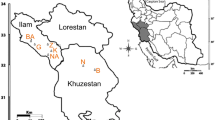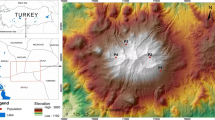Abstract
To provide a population-level genetic profile for investigation and conservation of genetic diversity of the sea buckthorn (Hippophae rhamnoides L.), 300 individuals of fifteen natural populations of sea buckthorn in China were analyzed by using ISSR (inter-simple sequence repeats) markers. On the basis of Shannon's index and Nei's genetic diversity, the mean genetic diversity detected in the natural populations of Hippophae rhamnoidesssp. yunnanensis, ssp. sinensis, and ssp. gyantsensis was 0.1944, 0.2169, and 0.1372, respectively. The coefficient of gene differentiation (Gst) of seven ssp. yunnanensis populations is 0.2790, and that of seven ssp. sinensis populations is 0.4184. This means that 28% of the total molecular variance of seven ssp. yunnanensis populations existed among populations, and 42% for seven ssp. sinensis populations, suggesting that the subspecies have different genetic structures. No significant correlation between genetic and geographic distances of the populations was found using ISSR markers.
Similar content being viewed by others
REFERENCES
Akulinin, I. A. (1958). Using sea-buckthorn oil in treating burns. Sov. Med. 11:137–138.
Barrett, S. C. H., and Kohn, J. R. (1991). Genetic and evolutionary consequences of small population size in plants. Implications for conservation. In Falk, D. A., and Holsinger, K. E. (eds.), Genetics and Conservation of Rare Plants, Oxford University Press, Oxford, pp. 3–30.
Bartish, I. V., Jeppsson, N., Bartish, G. I., Lu, R., and Nybom, H. (2000). Inter-and intraspecific genetic variation in Hippophae(Elaeagnaceae) investigated by RAPD markers. Plant Syst. Evol. 225:85–101.
Bartish, I. V., Jeppsson, N., and Nybom, H. (1999). Population genetic structure in the dioecious pioneer plant species Hippophae rhamnoidesinvestigated by random amplified polymorphic DNA (RAPD) markers. Mol. Ecol. 8:791–802.
Camacho, F. J., and Liston, A. (2001). Population structure and genetic diversity of Botrychium pumicola(Ophioglossaceae) based on inter-simple sequence repeats (ISSR). Am. J. Bot. 88:1065–1070.
Doyle, J. J., and Doyle, J. L. (1987). A rapid DNA isolation procedure for small quantities of fresh leaf tissue. Phytochemistry B 19:11–15.
Ge, X., Shi, G., and Zhang, Y. (1985). Application of sea-buckthorn in medicine. Shanxi Med. Res. 2:9–14.
Godwin, I. D., Aitken, E. A. B., and Smith, L. W. (1997). Application of inter-simple sequence repeat (ISSR) markers to plant genetics. Electrophoresis 18:1524–1528.
Hyvonen, J. (1996). On phylogeny of Hippophae(Elaeagnaceae). Nord. J. Bot. 16:51–62.
Isabel, N., Beaulieu, J., and Bousquet, J. (1995). Complete congruence between gene diversity estimates derived from genotypic data at enzyme and random amplified polymorphic DNA loci in black spruce. Proc. Natl. Acad. Sci. U.S.A. 98:985–994.
Lian, Y. (1988). New discoveries of the genus HippophaeL. (Elaeagnaceae). Acta Phytotax. Sin. 26:235–237.
Lynch, M. (1988). Estimation of relatedness by DNA fingerprinting. Mol. Biol. Evol. 5:584–599.
Lynch, M., and Milligan, B. G. (1994). Analysis of population genetic structure with RAPD markers. Mol. Ecol. 3:91–99.
Mantel, N. A. (1967). The detection of disease clustering and a generalized regression approach. Cancer Res. 27:209–220.
McKay, J. K., and Latta, R. G. (2002). Adaptive population divergence: Markers, QTL and traits. Trends Ecol. Evol. 17:285–291.
Merila, J., and Crnokrak, P. (2001). Comparison of genetic differentiation at marker loci and quantitative traits. J. Evol. Biol. 14:892–903.
Nebauer, S. G., Castillo-Agudo, L., and Segura, J. (1999). RAPD variation within and among natural populations of outcrossing willow-leaved foxglove (Digitalis obscuraL.). Theor. Appl. Genet. 98:985–994.
Nei, M. (1973). Analysis of gene diversity in subdivided population. Proc. Natl. Acad. Sci. U.S.A. 70:3321–3323.
Nei, M., and Li, W. H. (1979). Mathematical model for studying genetic variation in terms of restriction endonucleases. Proc. Natl. Acad. Sci. U.S.A. 76:5269–5273.
Reddy, M. P., Sarla, N., and Siddiq, E. A. (2002). Inter simple sequence repeat (ISSR) polymorphism and its application in plant breeding. Euphytica 128:9-17.
Rohlf, F. J. (1998). NTSYSpc: Numerical Taxonomy and Multivariate Analysis System, Version 2.02, Exeter Software, Setauket, New York.
Rousi, A. (1971). The genus HippophaeL. A taxonomic study. Ann. Bot. Fennici. 8:177–227.
Schroeder, W. R. (1990). Shelterbelt planting in the Canadian prairies. In Xiang, K. F., Shi, J. S., Baer, N.W. (eds.) Protective Plantation Technology, Publishing House of Northeast Forestry University, Harbin, People's Republic of China, pp. 35–43.
Sneath, P. H. A., and Sokal, R. R. (1973). Numerical Taxonomy, Freeman, San Francisco, CA.
Sokal, R. R., and Rohlf, F. J. (1995). Biometry, Freeman, New York.
Sun, K., Chen, X., Ma, R., Li, C., Wang, Q., and Ge, S. (2002). Molecular phylogenetics of HippophaeL. (Elaeagnaceae) based on the internal transcribed spacer (ITS) sequences of nrDNA. Plant Syst. Evol. 235:121–134.
Wolfe, A. D., and Liston, A. (1998). Contributions of PCR-based methods to plant systematics and evolutionary biology. In Soltis, P. S., Soltis, D. E., and Doyle, J. J. (eds.), Molecular Systematics of Plants: DNA Sequencing, Kluwer, New York, pp. 43–86.
Yao, Y. (1993). Effects of temperature sum on vitamin C concentration and yield of sea-buckthorn (Hippophae rhamnoides) fruit: Optimal time of fruit harvest. Agric. Sci. Finland 2:497–505.
Yao, Y., and Tigerstedt, P. M. A. (1993). Isozyme studies of genetic diversity and evolution in Hippophae. Genet. Res. Crop Evol. 42:153–164.
Yao, Y., and Tigerstedt, P. M. A. (1994). Genetic diversity in HippophaeL. and its use in plant breeding. Euphytica 77:165–169.
Yao, Y. M., and Tigerstedt, P. M. A. (1995). Geographical variation of growth rhythm, height, and hardiness, and their relations in Hippophae-rhamnoides. J. Am. Soc. Hortic. Sci. 120:691–698.
Yeh, F. C., Boyle, T., Yang, R. C., Ye, Z., and Xiyan, J. M. (1999). POPGENE, the user friendly shareware for population genetic analysis, Version 1.31, University of Alberta and Centre for International Forestry Research, Edmonton.
Author information
Authors and Affiliations
Corresponding author
Rights and permissions
About this article
Cite this article
Tian, C., Nan, P., Shi, S. et al. Molecular Genetic Variation in Chinese Populations of Three Subspecies of Hippophae rhamnoides . Biochem Genet 42, 259–267 (2004). https://doi.org/10.1023/B:BIGI.0000034430.93055.ff
Issue Date:
DOI: https://doi.org/10.1023/B:BIGI.0000034430.93055.ff




